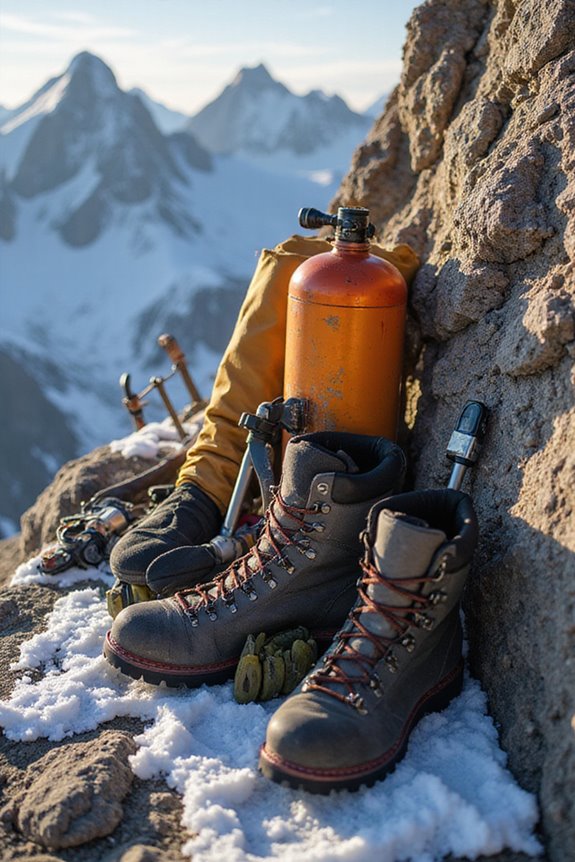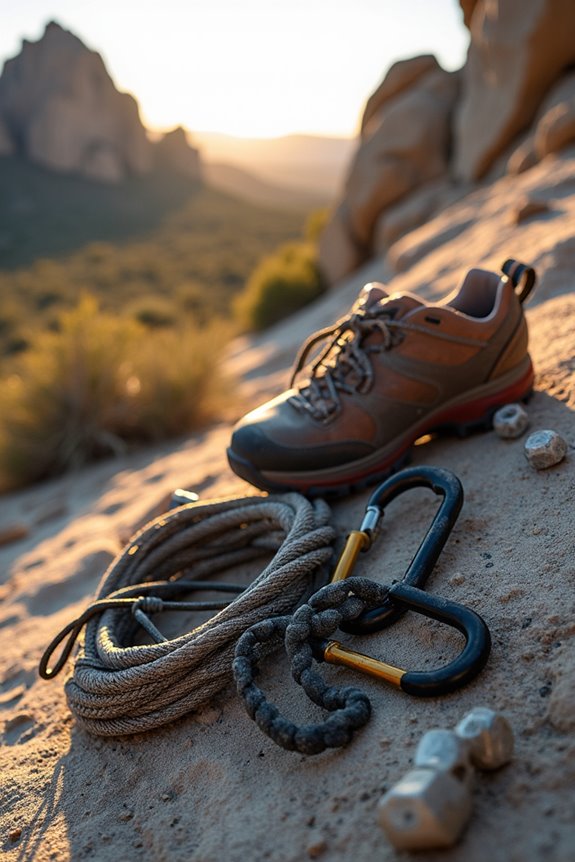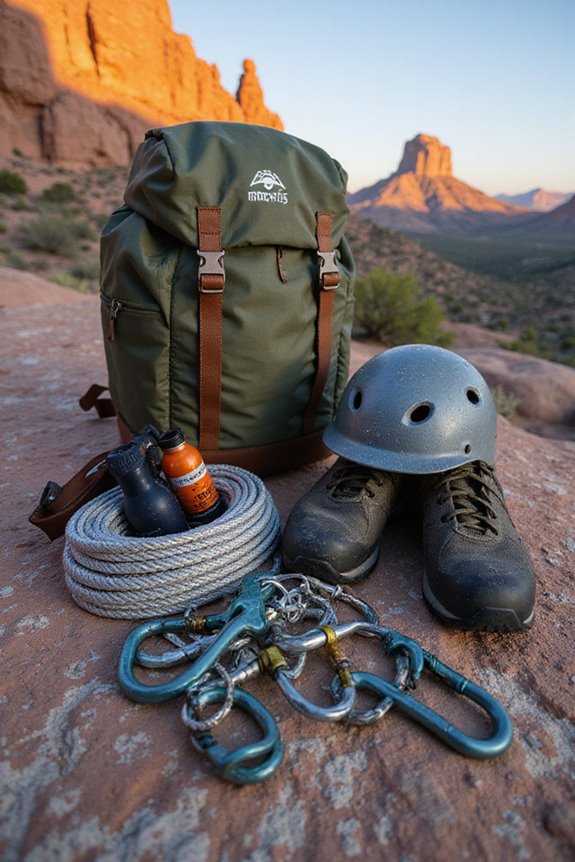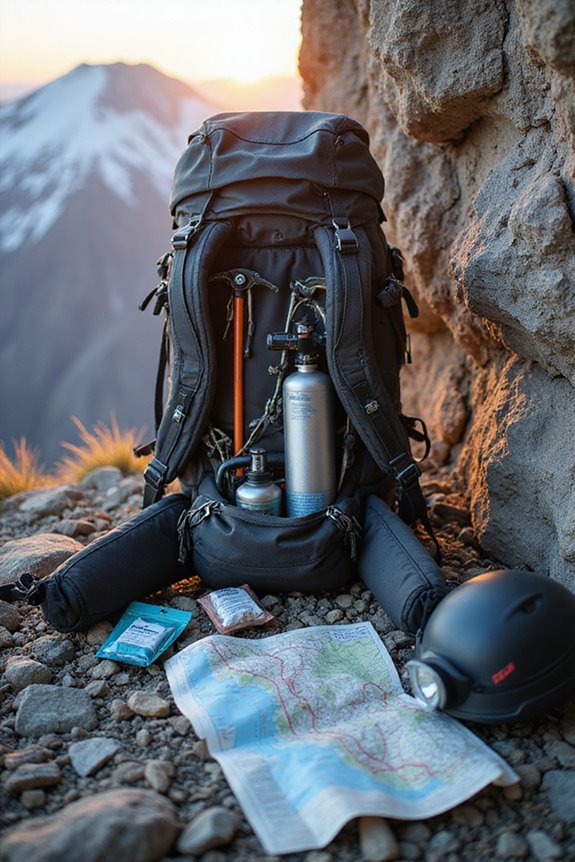When tackling high-altitude climbs, the right gear is our best friend! We need sturdy insulated boots, a durable harness, and modern crampons for icy slopes—that’s non-negotiable. Don’t forget a lightweight ice axe and a comfy helmet to keep debris at bay. And trust me, navigation tools like a Garmin inReach are lifesavers! So, grab your moisture-wicking layers and prepare to face the elements, because we’re about to conquer those peaks together. Stick around to discover more essential gear for your adventure!
Key Takeaways
- Use a durable harness and modern 12-point crampons for safety and stability on challenging icy slopes.
- Invest in insulated, waterproof boots with good ankle support and traction outsoles to ensure warmth and grip.
- Carry reliable navigation tools like Garmin devices for effective orientation and emergency communication.
- Pack a high-quality sleeping bag rated for extreme temperatures and insulating sleeping pads for overnight comfort.
- Include essential cold weather accessories such as hand warmers, hats, and gloves to maintain body warmth and comfort.
Essential Climbing Hardware
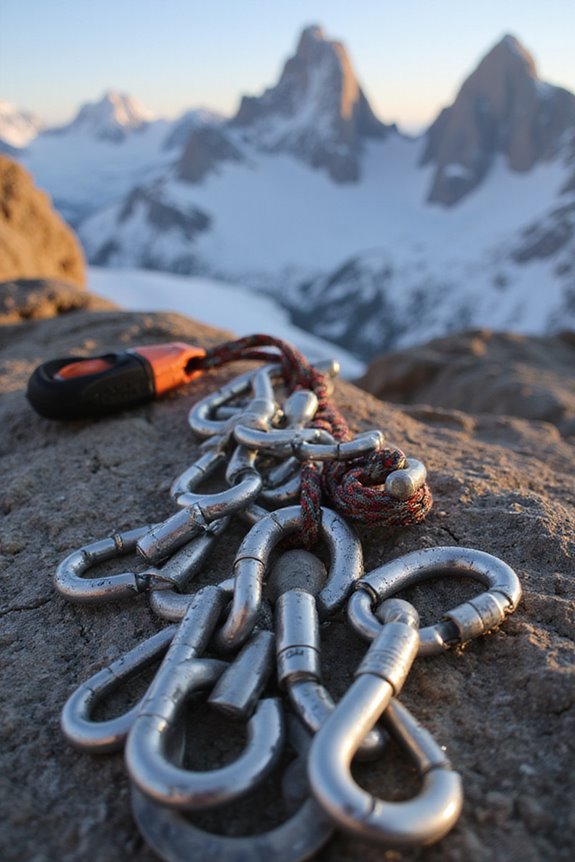
When it comes to high altitude climbing, having the right essential climbing hardware can make all the difference—trust me, I’ve been there! We’ve got to equip ourselves with high-quality climbing gear that meets safety standards to tackle those towering peaks. First up, a durable harness that fits perfectly over our thick layers is a must! Don’t forget modern 12-point crampons—these babies keep us steady on icy slopes. A lightweight ice axe under 60cm offers amazing mobility, while a comfy climbing helmet shields us from any surprise debris. Let’s also pack collapsible trekking poles for extra support. For optimal comfort during long expeditions, choose poles with padded cork grips that provide moisture-wicking benefits for sweaty hands. With the right gear, we’re set for adventures that’ll make our hearts soar, one summit at a time!
Navigation and Safety Devices
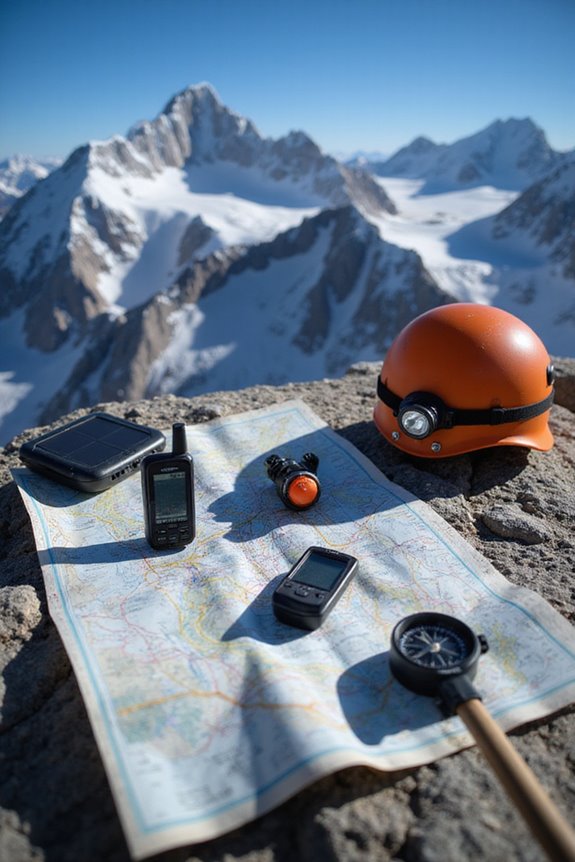
As we lace up our boots for another high-altitude adventure, it’s essential to talk about routefinding and safety devices—the unsung heroes of our treks! We’ve all heard the horror stories of lost climbers relying solely on their smartphones, right? That’s why we trust devices like Garmin inReach Explorer+ and GPSMAP models. With device reliability on our side, we can send SOS alerts or share live coordinates with family. Combining satellite communicators and our trusty map-and-compass skills is our safety net. And let’s face it, nothing makes you feel like a rugged mountain explorer quite like maneuvering with a compass and a little bit of finesse. For extended expeditions, consider the Garmin eTrex SE with its impressive 1,800 hours battery in expedition mode to ensure you never lose navigation capability. Remember, true freedom in the mountains comes from being prepared!
Footwear and Protection
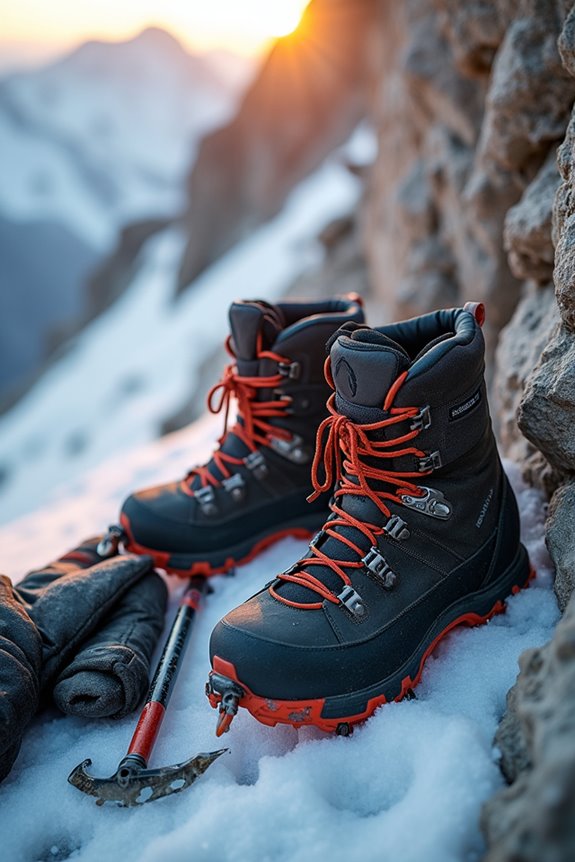
Strong footwear is our true foundation for conquering high-altitude adventures! When we’re tackling those dizzying heights, we can’t underestimate boot insulation—it’s essential for keeping our toes warm and cozy. Whether we’re sliding into 8,000-meter all-in-one boots or the trusty double boots, we need to guarantee a snug fit. It’s all about those fit adjustments; a well-fitted boot can make the difference between blissful freedom and a toe-crushing nightmare! Look for boots with advanced traction outsoles that provide superior grip on icy and unpredictable mountain terrain. While we embrace the rugged terrain, a durable gaiter integrated into our boots shields us from snow and moisture, keeping our minds focused on the climb. So let’s lace up, trust the technology, and venture confidently into the unknown—our next great expedition is waiting!
Trekking and Climbing Accessories
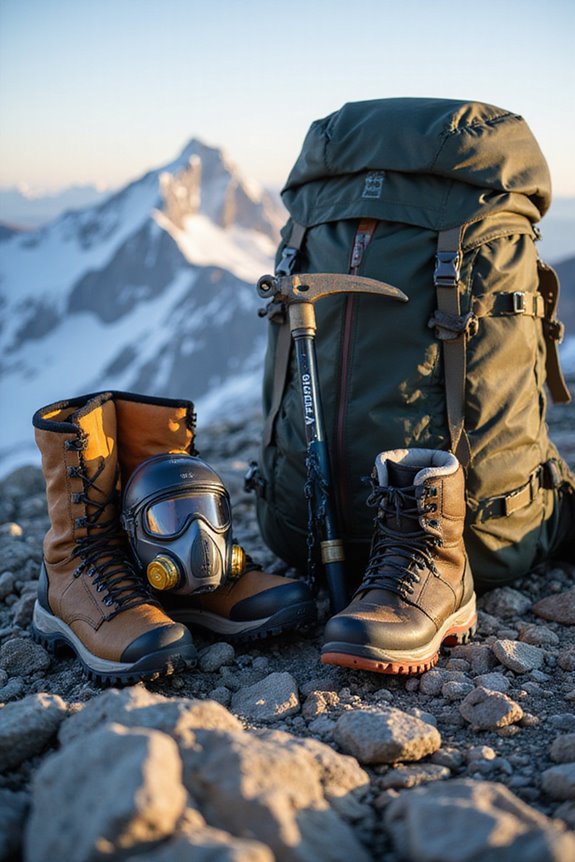
After lacing up those fantastic boots, we need to guarantee we’re equipped with the right trekking and climbing accessories to conquer high-altitude challenges. Let’s not skip on the trekking pole types! Collapsible poles with wide baskets give us stability on slippery snow—trust me, no one wants to end up on their rear! Consider selecting poles crafted from aircraft-grade aluminum for superior strength and durability while maintaining lightweight properties. And, when it comes to climbing, check out those harness features: adjustable leg loops keep us safe while allowing freedom of movement. We need to be able to scramble and ascend without feeling restricted. On top of that, lightweight helmets that fit over balaclavas are a game-changer. So, let’s gear up, release our adventurous spirit, and tackle those peaks together! Who’s ready?
Overnight and Cold Weather Gear
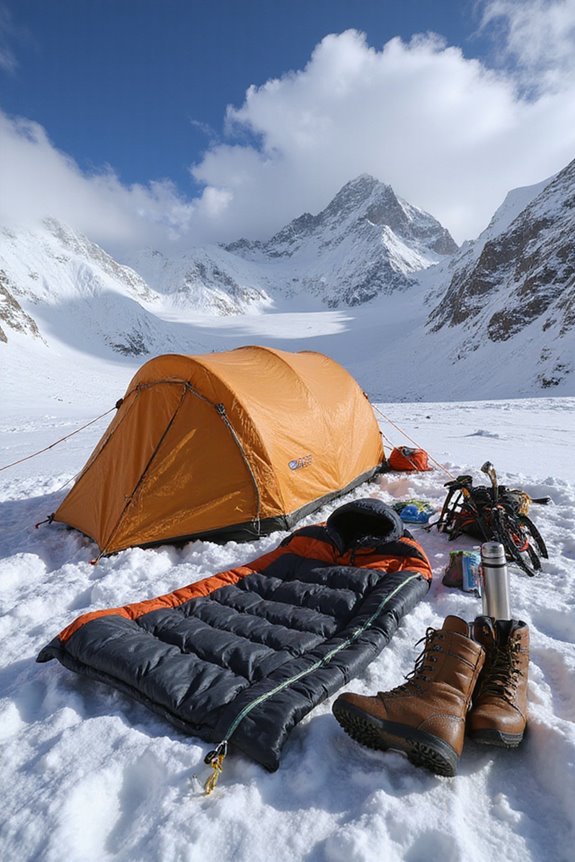
When planning for high-altitude adventures, we can’t overlook the importance of overnight and cold weather gear. A good night’s sleep can make all the difference, so we should consider exceptional sleeping bag options with ratings for those chilling 20s or teens. Down-filled bags are a dream for warmth-to-weight ratios! For extreme conditions, look for sleeping bags with temperature ratings below 10°F to ensure adequate protection. Let’s pair that with a solid double-layer sleeping pad to keep our backs cozy and insulated from the cold ground. Before crashing, we must pack essential cold weather accessories like hand warmers and a bag liner to boost warmth. Remember, it’s critical to keep our heads, hands, and necks toasty too! With the right gear, we’ll embrace the mountains with joy, knowing we’ve got what we need to thrive!
Communication and Emergency Essentials
As we gear up for those epic high-altitude climbs, let’s not underestimate the vital role of communication and emergency essentials! We’re talking about satellite communication devices like the Garmin inReach Mini, weighing just 100g but packing GPS tracking and SOS functionality. This little gem guarantees we stay connected, even in remote regions.
Don’t forget radio systems for real-time chatter—perfect for keeping tabs on the crew without depending on satellites. And let’s not overlook emergency signaling tools like personal locator beacons. They’ll be our lifesavers if tech fails us!
Layering Techniques for High Altitude
Staying warm and comfortable at high altitude is all about the layers, folks! We start with a solid base layer for moisture management—think soft merino wool to wick away sweat. Next up, our mid layer adds insulation balance, trapping body heat while keeping us breathable. Fleece or warm tech fabrics work wonders here! Finally, don’t forget that shell layer; it’s our shield against the elements, ensuring temperature regulation and protection from wind and water.
Layering flexibility is essential; we need those adjustment techniques ready for changing conditions. Oh, and sock layering? Vital for happy feet—nobody wants frozen toes! Let’s practice these techniques before our adventure. Embrace the freedom of moving comfortably, knowing we’ve got our layering game on lock!
Hydration Strategies on the Mountain
Hydration on the mountain isn’t just a good idea—it’s absolutely essential! Before we set out, we should pre-hydrate with at least 16-20 ounces a few hours prior. On the climb, let’s sip 7-10 ounces every 15-20 minutes—gulping can lead to a hydration disaster. We can keep our hydration systems handy and consider fun electrolyte mixes to soothe our taste buds while keeping our electrolyte balance in check.
When we pause for snacks, let’s wash them down to enhance absorption. And after a long day, we should replenish with nutrient-rich fluids to aid recovery. Staying hydrated not only fuels our adventures but keeps us feeling free and alive on those breathtaking trails. Let’s climb responsibly and hydrate proactively!
Personal and Group Safety Considerations
While we’re all about scaling heights and conquering trails, safety should always be our top priority. Every climber’s dream can quickly turn into a nightmare if we underestimate the climber risk involved in high altitude climbing. That’s why we gear up with helmets, harnesses, and gloves—don’t forget the hand protection!
In our group dynamics, communication is key; two-way radios can save the day if we’re out of cell range. We should always prep an emergency plan so everyone knows what to do when things go sideways. And remember, knowledge is power—having our first-aid supplies and understanding proper gear use is just as important as finding that next spectacular view. Let’s look out for each other and make every ascent an unforgettable adventure!
Frequently Asked Questions
How Do I Properly Fit a Climbing Harness?
To fit our climbing harness, we should focus on snug harness adjustments and comfort testing. We’ll test fit by ensuring it’s secure yet comfortable, allowing us the freedom to move without worrying about slips or discomfort.
What Should I Do in Case of an Avalanche?
What would we do if an avalanche strikes? Embracing avalanche safety, we’d instinctively move to the side, swim for the surface, and create air pockets—preparing our emergency response helps guarantee our freedom amidst the snow’s chaos.
How Can I Prevent Altitude Sickness Effectively?
To prevent altitude sickness effectively, we should prioritize acclimatization strategies and hydration importance. By gradually ascending and staying hydrated, we can enjoy the freedom of high-altitude adventures while minimizing risks to our well-being.
What Are the Signs of Hypothermia to Watch For?
As we embrace the thrill of the mountains, we must be vigilant for hypothermia symptoms. In cold weather, we might notice shivering, confusion, or blue lips—signs that demand our immediate attention and care.
How Do I Choose the Right Trekking Poles?
Choosing the right trekking poles involves understanding pole materials and how they affect our trekking techniques. We should prioritize lightweight, durable options with comfortable grips to enhance our climbing experience while enjoying nature’s freedom.

